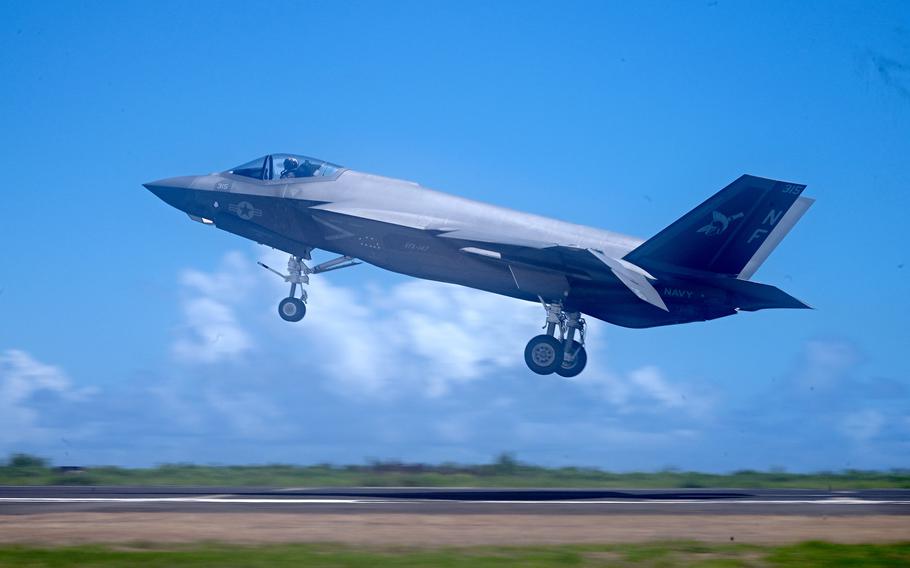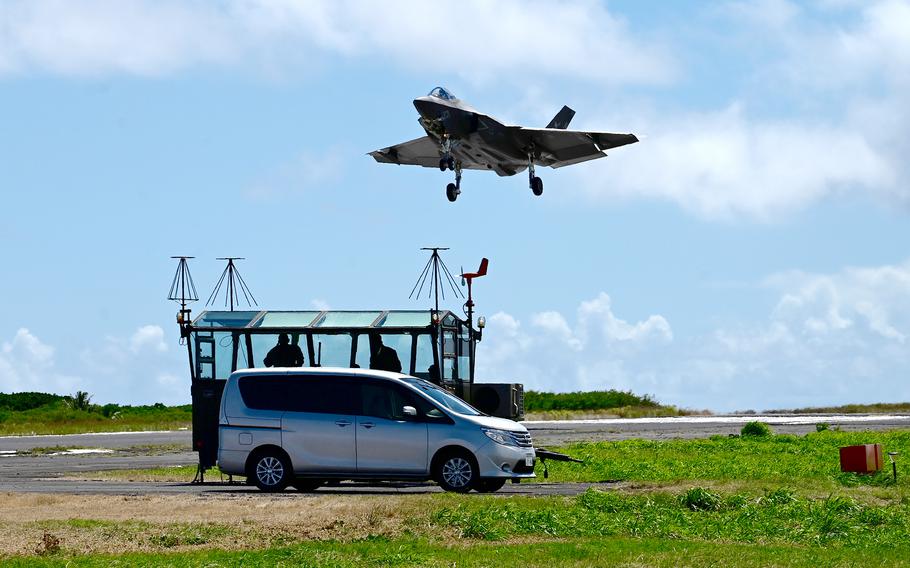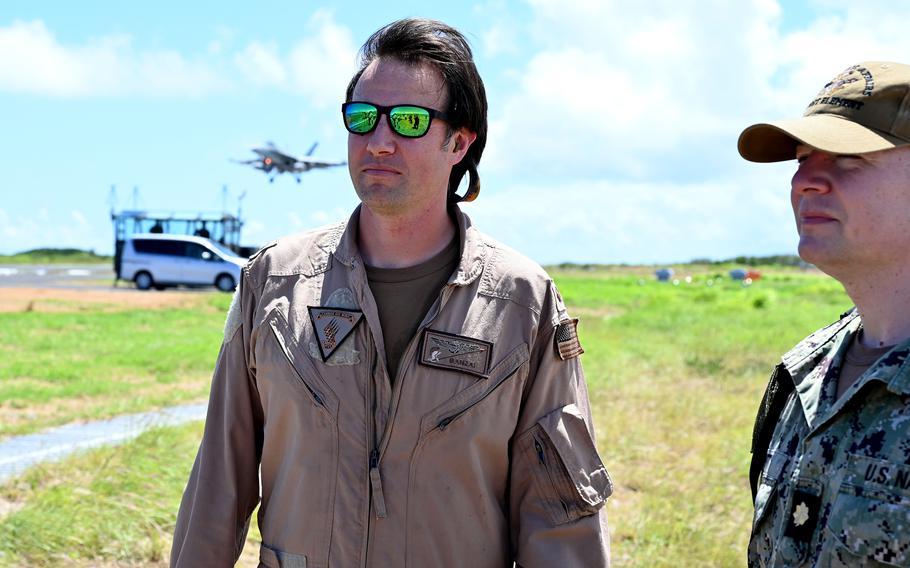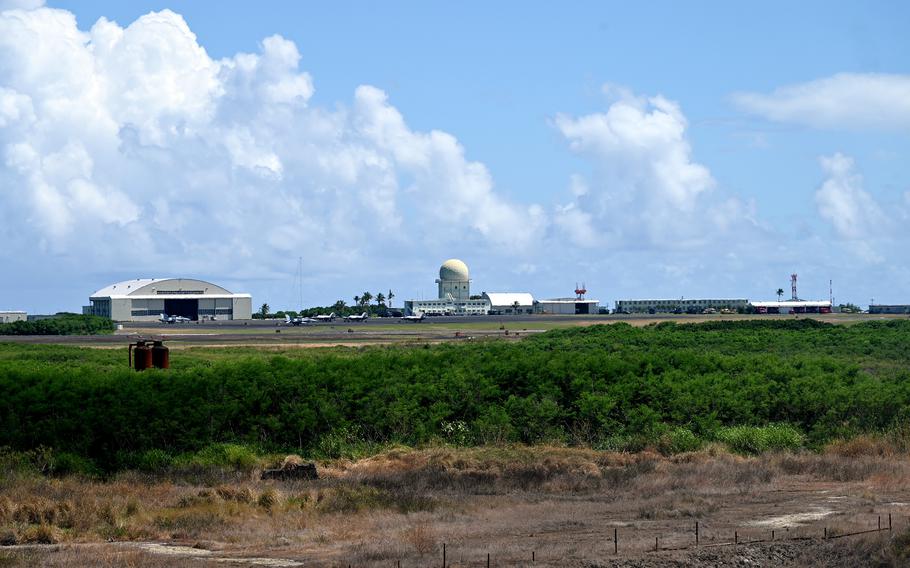
An F-35C Lightning II stealth fighter performs touch-and-goes during field carrier landing practice on Iwo Jima, Japan, on May 25, 2025. (Alex Wilson/Stars and Stripes)
IWO JIMA, Japan — U.S. Navy pilots are preparing for the USS George Washington’s inaugural patrol from its new homeport in Japan, conducting carrier-landing drills that, for the first time, include F-35C Lightning IIs on this historic island.
Iwo Jima — also known as Iwo To — has hosted field carrier landing practice since 1991 for aircraft such as the F/A-18 Super Hornet, EA-18G Growler and E-2D Hawkeye. But this year marks the first participation by the Navy’s most advanced fighter, said Naval Forces Japan spokesman Lt. Cmdr. Phillip Chitty.
Japanese government officials and media observed the training on Sunday. Pilots must complete these exercises before the George Washington, which left Yokosuka Naval Base that morning, officially begins its annual patrol.
“Field carrier-landing practices are required in order to qualify fixed-wing pilots, and they ensure that they have the practice and qualification in order to maintain readiness,” Chitty told reporters at a recreation facility on Iwo Jima.

An F-35C Lightning II stealth fighter takes part in field carrier landing practice on Iwo Jima, Japan, on May 25, 2025. (Alex Wilson/Stars and Stripes)
The drills, which began May 16 and end Saturday, involve a series of day and nighttime sorties, with repeated touch-and-go landings simulating conditions aboard a moving aircraft carrier.
The number of flights depends on pilot experience and how recently they last completed the training, said Capt. William Fallon, assistant chief of staff for operations, plans and training at Naval Forces Japan.
Veteran pilots typically fly a minimum of six sorties — three in daylight and three after dark — with seven or more touch-and-go landings. Junior aviators often complete additional runs.
Pilots also practice wave-offs, simulating scenarios where a landing is aborted at the direction of a landing signal officer. These interactions are later reviewed for performance, said Lt. Cmdr. Dan Landerholm, a landing signal officer with Strike Fighter Squadron 106 out of Naval Air Station Oceana in Virginia.

Lt. Cmdr. Dan Landerholm, left, a landing signal officer, and Lt. Cmdr. Philip Chitty, a Naval Forces Japan spokesman, observe field carrier landing practice on Iwo Jima, Japan, on May 25, 2025. (Alex Wilson/Stars and Stripes)
Landerholm said Iwo Jima’s conditions — particularly at night — offer a realistic simulation of carrier deck landings.
“This is crucial training before they go out to an extremely dynamic and demanding environment,” he told Stars and Stripes from the runway.
The visit was personal for Landerholm, who has Japanese heritage and said his great-uncle died on Iwo Jima during one of World War II’s most brutal battles.
“I had family on both sides of the war,” he said. “It’s especially meaningful given that it’s Memorial Day weekend.”
Despite its two decades of use, the Navy has long viewed Iwo Jima as a less-than-ideal training site. Located about 845 miles from Carrier Air Wing 5’s home base — Marine Corps Air Station Iwakuni in Yamaguchi prefecture — the island has no divert airfields and requires constant maintenance due to seismic activity.
“Iwo To is a remote, seismically active island that requires significant and continuous repairs to allow for [field carrier-landing practice] operations,” Chitty told reporters.
The Navy plans to relocate future practice to Mageshima, an island in Kagoshima prefecture roughly 250 miles from MCAS Iwakuni. The Japanese government is building a $2.4 billion base there, though the facility is running three years behind schedule and is not expected to be operational until 2030.

Iwo Jima's airfields are viewed from the Japanese island's Tenzan Monumement on May 25, 2025. (Alex Wilson/Stars and Stripes)